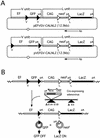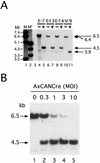Simultaneous on/off regulation of transgenes located on a mammalian chromosome with Cre-expressing adenovirus and a mutant loxP
- PMID: 12853653
- PMCID: PMC167663
- DOI: 10.1093/nar/gng076
Simultaneous on/off regulation of transgenes located on a mammalian chromosome with Cre-expressing adenovirus and a mutant loxP
Abstract
The site-specific recombinase Cre has often been used for on/off regulation of expression of transgenes introduced into the mammalian chromosome. However, this method is only applicable to the regulation of a single gene and cannot be used to simultaneously regulate two genes, because site-specific recombination occurs from the target loxP sequence of one regulating unit to the loxP sequence of any other unit and would eventually disrupt the structure of both regulating units. We previously reported a mutant loxP sequence with a two base substitution called loxP V (previously called loxP 2272), with which wild-type loxP cannot recombine but with which the identical mutant loxP recombines efficiently. In the present study we isolated cell lines bearing two regulating units on a chromosome containing a pair of wild-type loxP sequences or mutant loxP V sequences. After infection with Cre-expressing recombinant adenovirus AxCANCre, expression of a gene in each regulating unit was simultaneously turned on and off. Southern analyses showed that both regulating units were processed simultaneously and independently, even after infection with a limited amount of AxCANCre. The results showed that simultaneous regulation of gene expression on a mammalian chromosome mediated by Cre can be achieved by using mutant loxP V and wild-type loxP. This method may be a useful approach for conditional transgenic/knockout animals and investigation of gene function involving two genes simultaneously. Another possible application is for preparation of a new packaging cell line of viral vectors through simultaneous production of toxic viral genes.
Figures








Similar articles
-
Efficient gene activation system on mammalian cell chromosomes using recombinant adenovirus producing Cre recombinase.Gene. 1996 Nov 28;181(1-2):207-12. doi: 10.1016/s0378-1119(96)00516-1. Gene. 1996. PMID: 8973332
-
Efficient gene activation in cultured mammalian cells mediated by FLP recombinase-expressing recombinant adenovirus.Nucleic Acids Res. 2001 Apr 1;29(7):E40. doi: 10.1093/nar/29.7.e40. Nucleic Acids Res. 2001. PMID: 11266575 Free PMC article.
-
Temporal activation of c-Jun N-terminal kinase in adult transgenic heart via cre-loxP-mediated DNA recombination.FASEB J. 2003 Apr;17(6):749-51. doi: 10.1096/fj.02-0438fje. Epub 2003 Feb 19. FASEB J. 2003. PMID: 12594183
-
Strategies of conditional gene expression in myocardium: an overview.Methods Mol Med. 2005;112:109-54. doi: 10.1007/978-1-59259-879-3_8. Methods Mol Med. 2005. PMID: 16010014 Review.
-
Modifiable gene expression in mice: kidney-specific deletion of a target gene via the cre-loxP system.Exp Nephrol. 1998 Nov-Dec;6(6):568-75. doi: 10.1159/000020573. Exp Nephrol. 1998. PMID: 9807030 Review.
Cited by
-
Production of viral vectors using recombinase-mediated cassette exchange.Nucleic Acids Res. 2005 May 5;33(8):e76. doi: 10.1093/nar/gni074. Nucleic Acids Res. 2005. PMID: 15879348 Free PMC article.
-
An efficient system to establish multiple embryonic stem cell lines carrying an inducible expression unit.Nucleic Acids Res. 2005 Mar 1;33(4):e43. doi: 10.1093/nar/gni043. Nucleic Acids Res. 2005. PMID: 15741176 Free PMC article.
-
Mice deficient in collapsin response mediator protein-1 exhibit impaired long-term potentiation and impaired spatial learning and memory.J Neurosci. 2007 Mar 7;27(10):2513-24. doi: 10.1523/JNEUROSCI.4497-06.2007. J Neurosci. 2007. PMID: 17344389 Free PMC article.
-
Loss of MAT2A compromises methionine metabolism and represents a vulnerability in H3K27M mutant glioma by modulating the epigenome.Nat Cancer. 2022 May;3(5):629-648. doi: 10.1038/s43018-022-00348-3. Epub 2022 Apr 14. Nat Cancer. 2022. PMID: 35422502 Free PMC article.
References
-
- Sternberg N. and Hamilton,D. (1981) Bacteriophage P1 site-specific recombination. I. Recombination between loxP sites. J. Mol. Biol., 150, 467–486. - PubMed
-
- Barinaga M. (1994) Knockout mice: round two. Science, 265, 26–28. - PubMed
-
- Rossant J. and Nagy,A. (1995) Genome engineering: the new mouse genetics. Nature Med., 1, 592–594. - PubMed
-
- Lewandoski M. (2001) Conditional control of gene expression in the mouse. Nature Rev. Genet., 2, 743–755. - PubMed
Publication types
MeSH terms
Substances
LinkOut - more resources
Full Text Sources
Other Literature Sources

